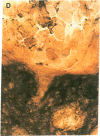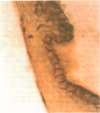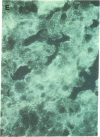Abstract
A murine monoclonal antibody was generated against human skin cells obtained from psoriatic plaques. The antibody, called VM-2, recognizes an epitope expressed on the basal cell layer of human skin and other epithelia. VM-2 also binds to cultured cells from a variety of human carcinomas including HeLa cervical carcinoma, A-431 vulvar carcinoma, A-549 lung alveolar carcinoma, and SCL-1 skin squamous cell carcinoma cells. In several primary human cell lines, including fibroblasts, endothelial cells, and cells from the hematopoietic lineage, the antigenic site recognized by VM-2 could not be detected. The cellular antigen when immunoprecipitated by VM-2 from both normal and transformed cells appears to be proteins of approximately 100,000 and 120,000 mol weight. In frozen sections from human tumor-containing tissues, VM-2 labels skin, cervical, and lung squamous carcinoma cells, as well as skin basal carcinoma cells. Malignant cells present in exfoliative smears from epidermoid invasive neoplasias of the cervix are also selectively recognized by VM-2 in distinction to normal squamous cervical cells. VM-2 is thus directed against an antigen associated with neoplastic cells when applied in selected sites of exfoliative cytology. This monoclonal antibody represents a new reagent that should prove useful in the diagnosis of cervical neoplasia.
Full text
PDF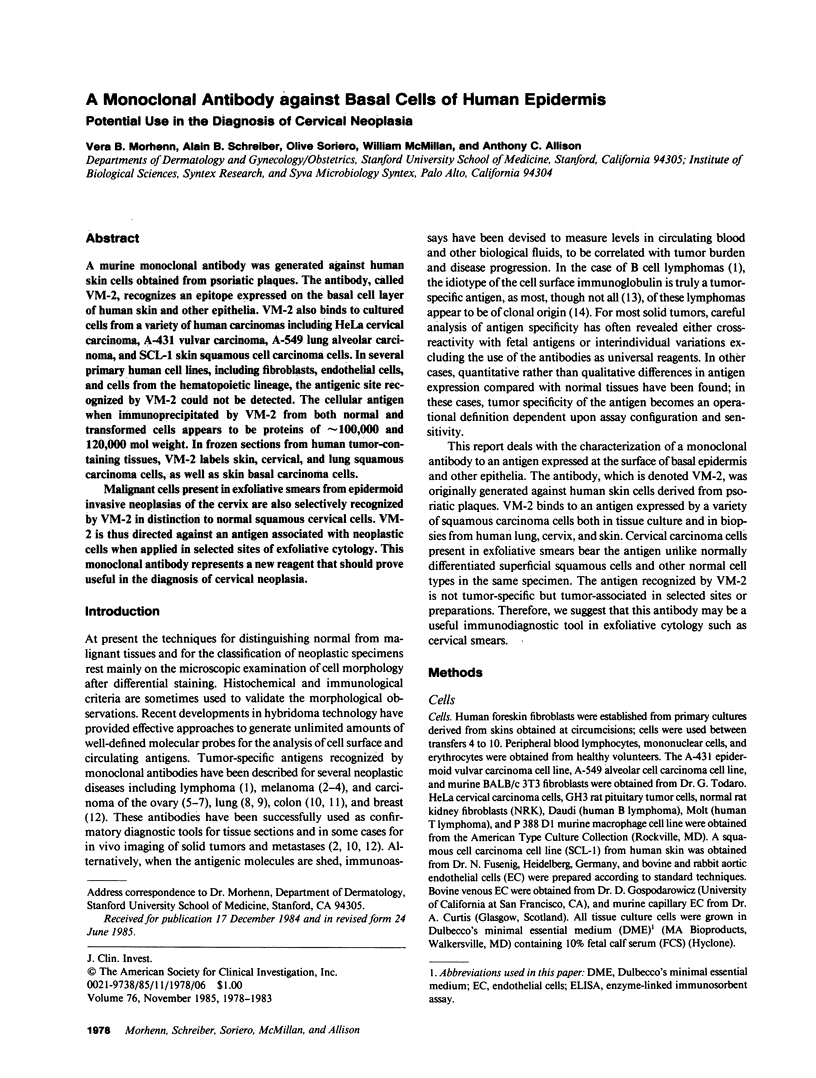
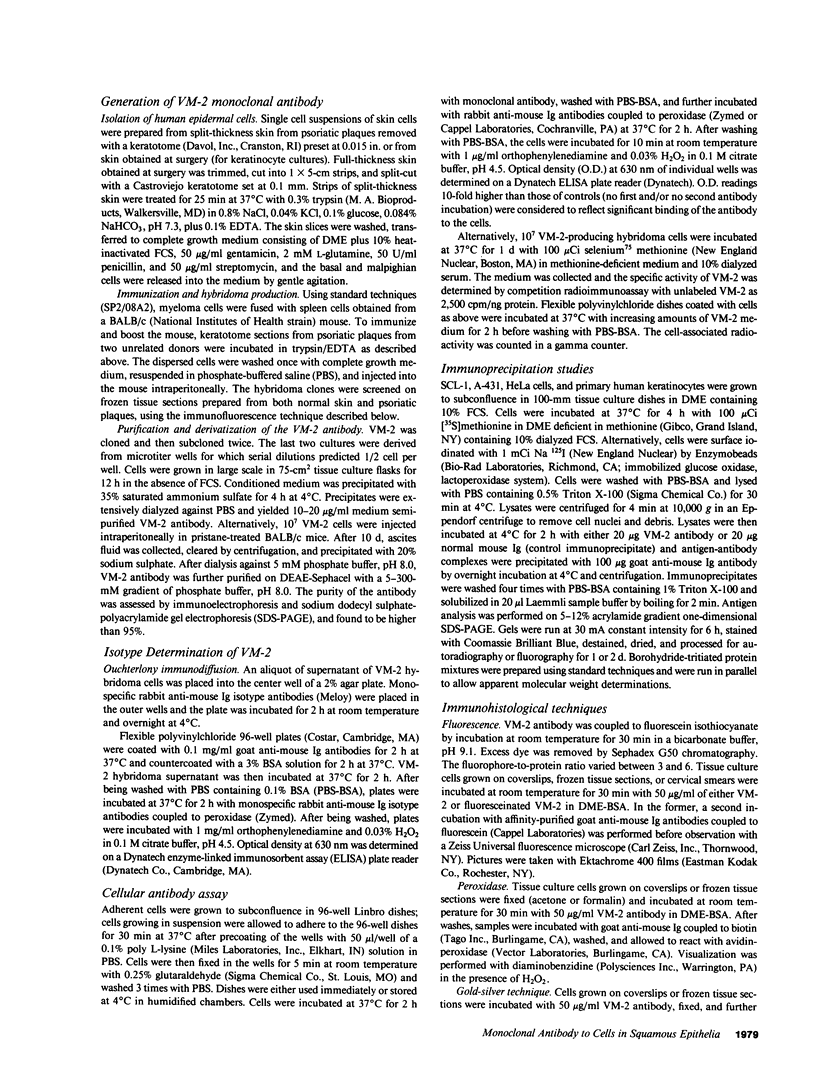
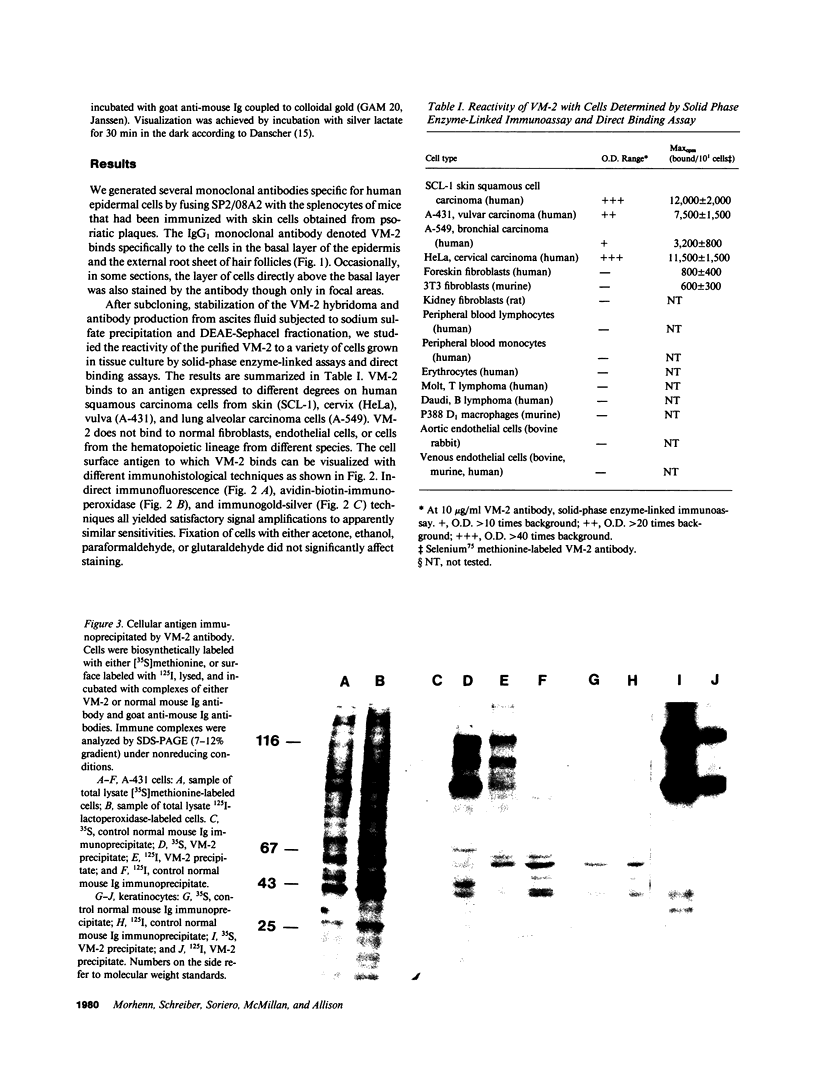
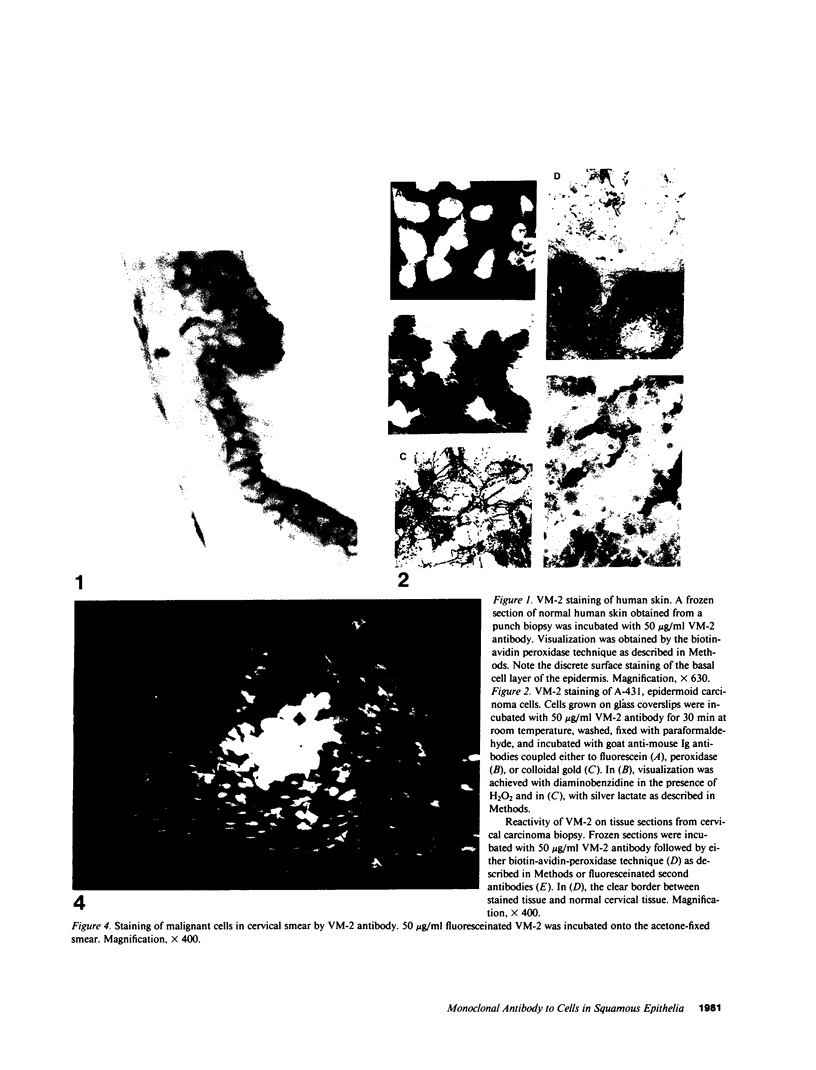
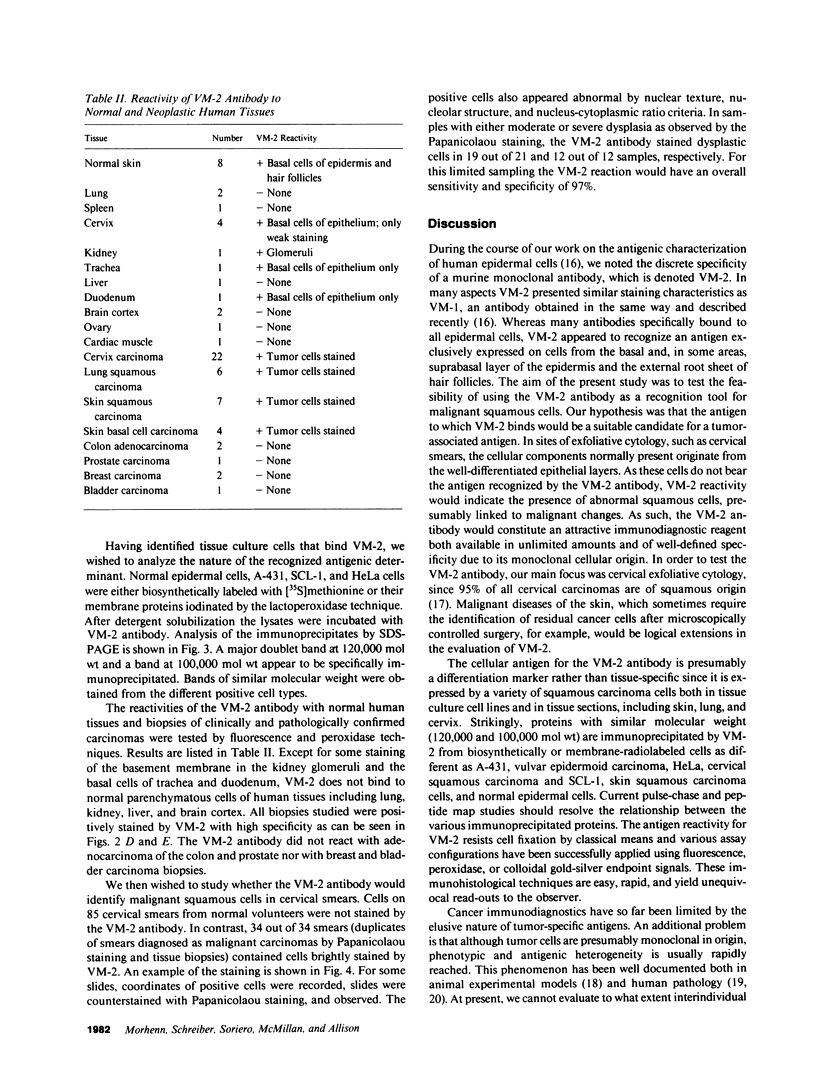
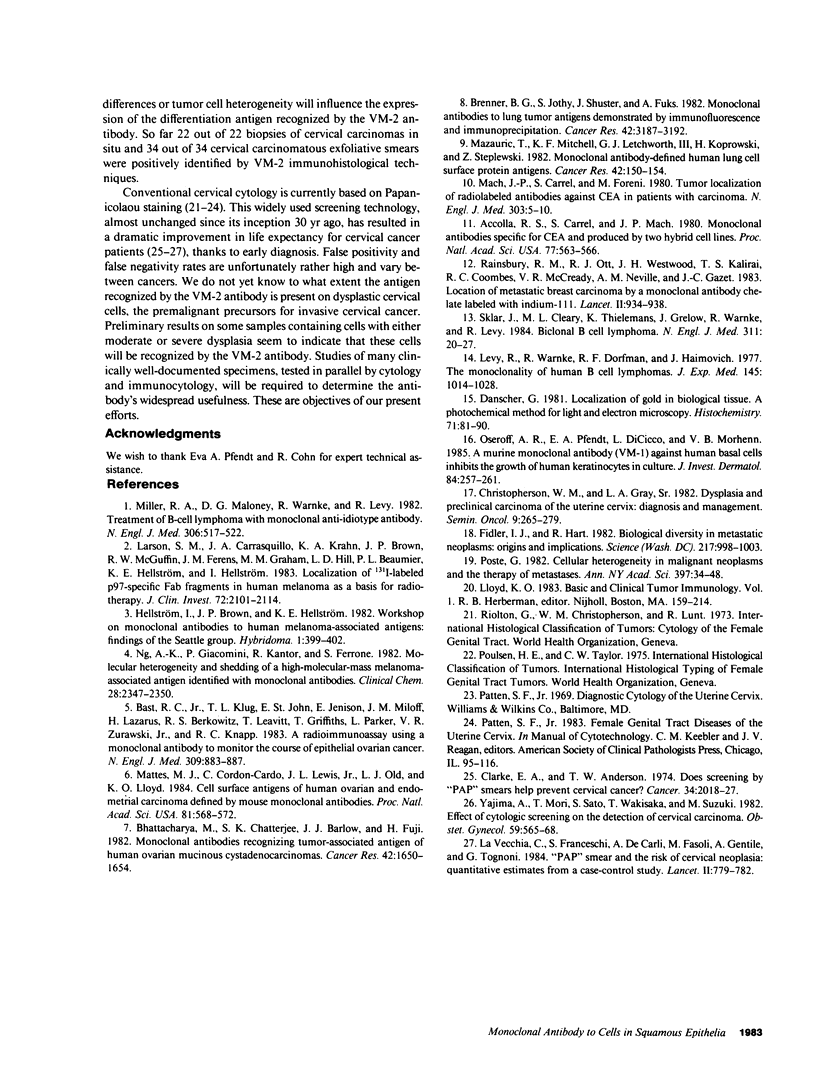
Images in this article
Selected References
These references are in PubMed. This may not be the complete list of references from this article.
- Accolla R. S., Carrel S., Mach J. P. Monoclonal antibodies specific for carcinoembryonic antigen and produced by two hybrid cell lines. Proc Natl Acad Sci U S A. 1980 Jan;77(1):563–566. doi: 10.1073/pnas.77.1.563. [DOI] [PMC free article] [PubMed] [Google Scholar]
- Bast R. C., Jr, Klug T. L., St John E., Jenison E., Niloff J. M., Lazarus H., Berkowitz R. S., Leavitt T., Griffiths C. T., Parker L. A radioimmunoassay using a monoclonal antibody to monitor the course of epithelial ovarian cancer. N Engl J Med. 1983 Oct 13;309(15):883–887. doi: 10.1056/NEJM198310133091503. [DOI] [PubMed] [Google Scholar]
- Bhattacharya M., Chatterjee S. K., Barlow J. J., Fuji H. Monoclonal antibodies recognizing tumor-associated antigen of human ovarian mucinous cystadenocarcinomas. Cancer Res. 1982 May;42(5):1650–1654. [PubMed] [Google Scholar]
- Brenner B. G., Jothy S., Shuster J., Fuks A. Monoclonal antibodies to human lung tumor antigens demonstrated by immunofluorescence and immunoprecipitation. Cancer Res. 1982 Aug;42(8):3187–3192. [PubMed] [Google Scholar]
- Christopherson W. M., Gray L. A., Sr Dysplasia and preclinical carcinoma of the uterine cervix: diagnosis and management. Semin Oncol. 1982 Sep;9(3):265–279. [PubMed] [Google Scholar]
- Cramer D. W. The role of cervical cytology in the declining morbidity and mortality of cervical cancer. Cancer. 1974 Dec;34(6):2018–2027. doi: 10.1002/1097-0142(197412)34:6<2018::aid-cncr2820340621>3.0.co;2-b. [DOI] [PubMed] [Google Scholar]
- Danscher G. Localization of gold in biological tissue. A photochemical method for light and electronmicroscopy. Histochemistry. 1981;71(1):81–88. doi: 10.1007/BF00592572. [DOI] [PubMed] [Google Scholar]
- Fidler I. J., Hart I. R. Biological diversity in metastatic neoplasms: origins and implications. Science. 1982 Sep 10;217(4564):998–1003. doi: 10.1126/science.7112116. [DOI] [PubMed] [Google Scholar]
- Hellström I., Brown J. P., Hellström K. E. Workshop on monoclonal antibodies to human melanoma-associated antigens: findings of the Seattle group. Hybridoma. 1982;1(4):399–402. doi: 10.1089/hyb.1.1982.1.399. [DOI] [PubMed] [Google Scholar]
- La Vecchia C., Franceschi S., Decarli A., Fasoli M., Gentile A., Tognoni G. "Pap" smear and the risk of cervical neoplasia: quantitative estimates from a case-control study. Lancet. 1984 Oct 6;2(8406):779–782. doi: 10.1016/s0140-6736(84)90705-0. [DOI] [PubMed] [Google Scholar]
- Larson S. M., Carrasquillo J. A., Krohn K. A., Brown J. P., McGuffin R. W., Ferens J. M., Graham M. M., Hill L. D., Beaumier P. L., Hellström K. E. Localization of 131I-labeled p97-specific Fab fragments in human melanoma as a basis for radiotherapy. J Clin Invest. 1983 Dec;72(6):2101–2114. doi: 10.1172/JCI111175. [DOI] [PMC free article] [PubMed] [Google Scholar]
- Levy R., Warnke R., Dorfman R. F., Haimovich J. The monoclonality of human B-cell lymphomas. J Exp Med. 1977 Apr 1;145(4):1014–1028. doi: 10.1084/jem.145.4.1014. [DOI] [PMC free article] [PubMed] [Google Scholar]
- Mach J. P., Carrel S., Forni M., Ritschard J., Donath A., Alberto P. Tumor localization of radiolabeled antibodies against carcinoembryonic antigen in patients with carcinoma: a critical evaluation. N Engl J Med. 1980 Jul 3;303(1):5–10. doi: 10.1056/NEJM198007033030102. [DOI] [PubMed] [Google Scholar]
- Mattes M. J., Cordon-Cardo C., Lewis J. L., Jr, Old L. J., Lloyd K. O. Cell surface antigens of human ovarian and endometrial carcinoma defined by mouse monoclonal antibodies. Proc Natl Acad Sci U S A. 1984 Jan;81(2):568–572. doi: 10.1073/pnas.81.2.568. [DOI] [PMC free article] [PubMed] [Google Scholar]
- Mazauric T., Mitchell K. F., Letchworth G. J., 3rd, Koprowski H., Steplewski Z. Monoclonal antibody-defined human lung cell surface protein antigens. Cancer Res. 1982 Jan;42(1):150–154. [PubMed] [Google Scholar]
- Miller R. A., Maloney D. G., Warnke R., Levy R. Treatment of B-cell lymphoma with monoclonal anti-idiotype antibody. N Engl J Med. 1982 Mar 4;306(9):517–522. doi: 10.1056/NEJM198203043060906. [DOI] [PubMed] [Google Scholar]
- Ng A. K., Giacomini P., Kantor R., Ferrone S. Molecular heterogeneity and shedding of a high-molecular-mass melanoma-associated antigen identified with monoclonal antibodies. Clin Chem. 1982 Dec;28(12):2347–2350. [PubMed] [Google Scholar]
- Oseroff A. R., Pfendt E. A., DiCicco L., Morhenn V. B. A murine monoclonal antibody (VM-1) against human basal cells inhibits the growth of human keratinocytes in culture. J Invest Dermatol. 1985 Apr;84(4):257–261. doi: 10.1111/1523-1747.ep12265330. [DOI] [PubMed] [Google Scholar]
- Poste G. Cellular heterogeneity in malignant neoplasms and the therapy of metastases. Ann N Y Acad Sci. 1982 Dec 10;397:34–48. doi: 10.1111/j.1749-6632.1982.tb43415.x. [DOI] [PubMed] [Google Scholar]
- Rainsbury R. M., Ott R. J., Westwood J. H., Kalirai T. S., Coombes R. C., McCready V. R., Neville A. M., Gazet J. C. Location of metastatic breast carcinoma by a monoclonal antibody chelate labelled with indium-111. Lancet. 1983 Oct 22;2(8356):934–938. doi: 10.1016/s0140-6736(83)90452-x. [DOI] [PubMed] [Google Scholar]
- Sklar J., Cleary M. L., Thielemans K., Gralow J., Warnke R., Levy R. Biclonal B-cell lymphoma. N Engl J Med. 1984 Jul 5;311(1):20–27. doi: 10.1056/NEJM198407053110104. [DOI] [PubMed] [Google Scholar]
- Yajima A., Mori T., Sato S., Wakisaka T., Suzuki M. Effect of cytologic screening on the detection of cervical carcinoma. Obstet Gynecol. 1982 May;59(5):565–568. [PubMed] [Google Scholar]




